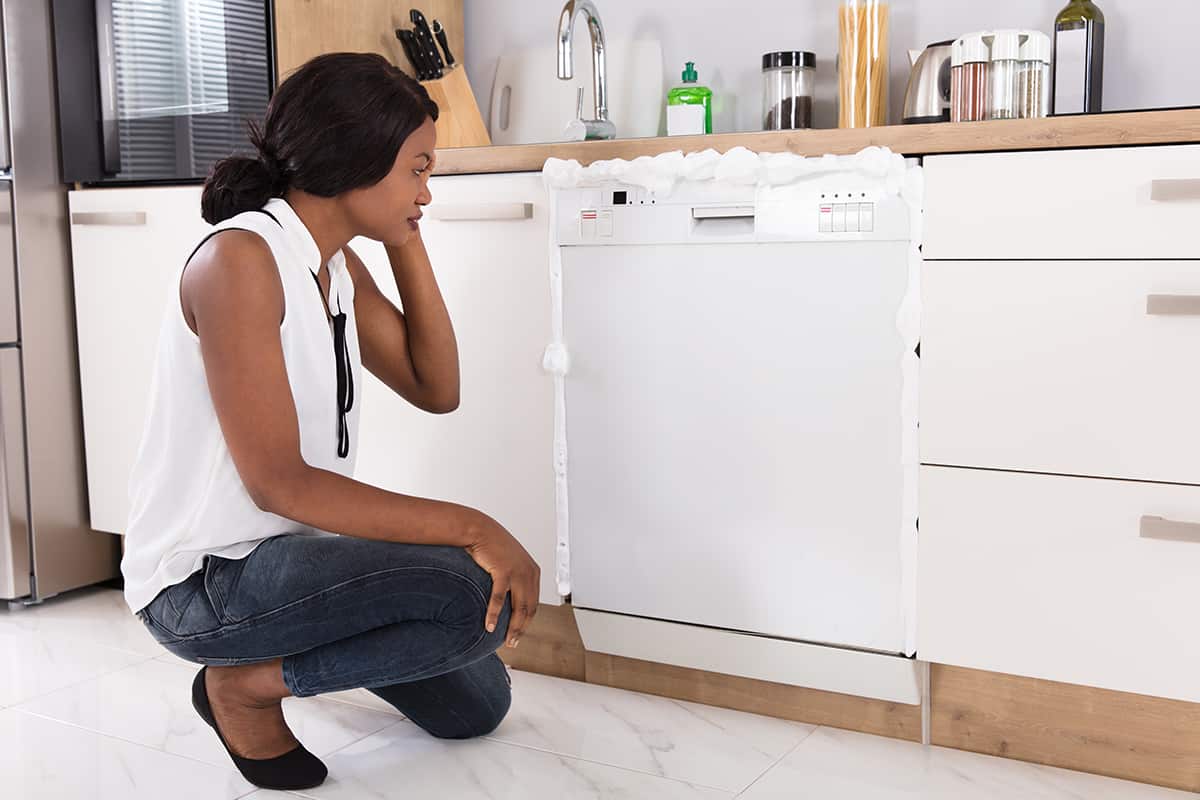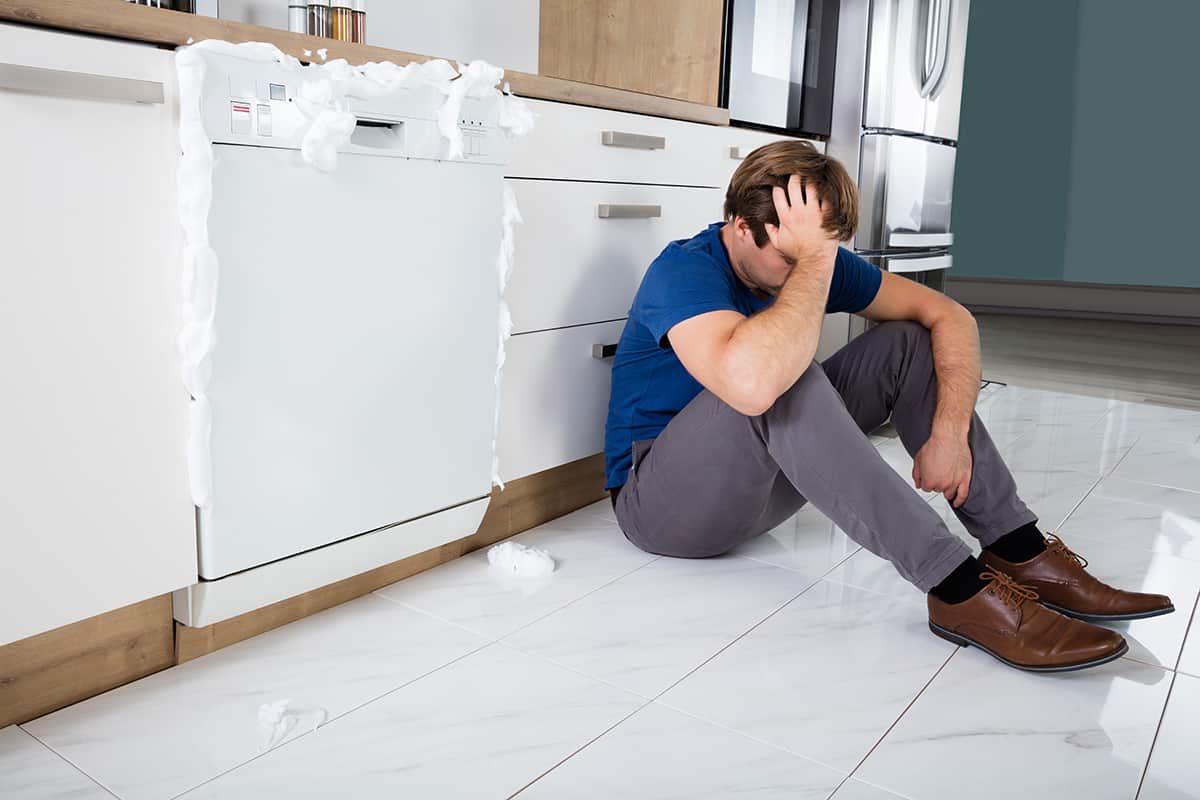Whirlpool is one of the most reliable home appliance manufacturers on the planet. One of the brand’s greatest selling points is its ultra-generous warranty offers, so you can feel more confident in your purchase. However, when it comes to Whirlpool dishwashers, there are 2 common maintenance issues that will arise over time: failing to drain and spray water.
There are several reasons why your Whirlpool dishwasher might not drain or spray water properly. In extreme cases, the hardware of your dishwasher might be at fault, but more frequently, improper dishwasher care will lead to draining and spraying failure.
With that said, let’s explore the various causes of why your Whirlpool dishwasher might experience technical difficulties, even before it hits the third-year mark. In this guide, I’ll explain why your Whirlpool dishwasher won’t drain or spray water and the troubleshooting methods to get your dishwasher running again like new.
Whirlpool Dishwasher Not Draining
When your dishwasher doesn’t drain water, that means there is standing water at the bottom of the machine. This doesn’t just lead to mold growth, which can be impossible to eradicate, but it can also lead to a buildup of bacteria that release foul-smelling odors with time.
If your Whirlpool dishwasher doesn’t drain water, here’s what to look for and what you can do about it.
Stuck Mid-Cycle
If you notice standing water at the bottom of your dishwasher, there’s a good chance that the machine lost power mid-cycle. When power is restored, your dishwasher will turn back on, but some models don’t have an auto-resume function, so it will be stuck in an infinite cycle of doing nothing.
Check for Clean indicator light. If it’s not on, that means the wash cycle was interrupted at some point, and you will need to restart the machine and run the cycle anew.
Clogged Drain Line
Another common reason for standing water is that the drain line is clogged. Over time, any solid bits that you might have failed to scrub off your dirty dishes will fall to the bottom and eventually find their way into the drain line. When this happens, it will stop water from draining completely.
First, if your dishwasher is connected to your sink’s garbage disposal, check for blockages. You can use a long tool, such as a wooden spoon, to pick out any solid remnants from the garbage disposal or pour a 1:4 solution of baking soda and water into the sink’s drain, let it sit for 15-20 minutes, and flush it with cold water.
Clogged Filter
At the base of your dishwasher, underneath the spray arm, you will find a circular object. That is the filter assembly, and its only job is to capture solid debris from making its way down the drain line. Over time, it may become clogged, especially when you fail to scrub food remnants off of the dirty plates before inserting them into the dishwasher.
To clean the filter assembly, remove it from the dishwasher, disassemble the filter, and wash and scrub the components individually. When dealing with the fine-mesh filter, use a soft-bristle brush after soaking it in soapy water for 5-10 minutes. When the filter assembly is clean, reassemble it and reinstall it inside the dishwasher.
Kinked Drain Line
Improper installing or positioning of the drain line may cause it to kink or twist over time. This is typically caused by the high-pressure flow of water exiting the machine and making its way into the drain line, garbage disposal, and sewer line.
Turn off the dishwasher before moving it forward to gain access to the drain line. Check the line for kinks or signs of wear and tear. When the kink is undone, push your dishwasher back into place and run a test cycle.
Improperly Installed Garbage Disposal
For those that have recently installed a garbage disposal and connected their dishwasher to the unit, you will need to ensure that you have installed it properly. If not, the drain line back cause water to flow back into the machine.
Check to see whether the knock-out plug was removed. It’s the plug that resides in the connection point between the garbage disposal and the dishwasher’s drain line.
Damaged Drain Pump
Over time, the drain pump, like any other component inside the dishwasher, may become prone to failure. Regardless of what cycle you run, the drain pump will always be activated at one point, and this can lead to premature failure if you run your dishwasher more than 5 times per week.
If you do not know how to access the drain pump, or if you don’t have a multimeter, call a repair contractor to check it out. You will need to check for a current to determine whether or not the pump is functional.
Whirlpool Dishwasher Not Spraying Water

As you may already know, your dishwasher needs to spray water to rinse all of the pots, pans, plates, and cutlery within. The water comes from the spray arm, which shoots upward to blast away caked-on food remnants and layers of grease.
However, a faulty spray arm isn’t the only reason your Whirlpool dishwasher isn’t spraying water. Let’s examine the various reasons as to why this is and what you can do to resolve the issue.
Closed Inlet Valve
When water doesn’t pour out of the spray arm, the first thing you should check is whether the water inlet valve is opened. If not, no water will come spraying into the machine. In extreme cases, the water inlet valve might have become blocked, and you will need to replace it or manually remove the blockage to restore water flow.
Faulty Spray Arm
The spray arm is a component inside the machine that has tiny holes. High-pressure water from the water inlet valve shoots out of the holes, and the built-up pressure will cause the spray arm to rotate as it sprays the interior of your dishwasher. Over time, solid bits might have fallen into the spray arm’s holes, preventing it from spraying water.
You can detach the spray arm, soak it in soapy water, and use a toothpick to manually remove any bits of debris residing in each hole. If this doesn’t work, you might need to replace the spray arm entirely.
Overloaded Dishwasher
If your dishwasher appears like it’s not spraying water—perhaps there are still solid bits of old food stuck on the surface of your dishes—your dishwasher might be overloaded. Overloading the racks will prevent the water from reaching every part of your dishes, leaving some parts soapy and some parts unrinsed.
Consult the Whirlpool dishwasher’s instruction manual to see how to properly load the dishracks. You might need to run your wash cycles in batches to clean all of your dishes.
Damaged Circulation Pump
The circulation pump’s sole purpose is to pump water from the inlet valve to the dishwasher’s spray arm. When this pump becomes damaged, it can prevent water from reaching the spray arm or lower water pressure, thereby causing only a trickle of water to spray out or stopping it from spraying completely.
You can tell whether the circulation pump is on the fritz. During a rinse cycle, listen closely to the sound of the dishwasher. If it sounds like it’s struggling, or if it doesn’t make any sound at all, the circulation pump might be in trouble. In this case, you might have to replace the pump or get it fixed by a professional.
Damaged Water Impeller
The water impeller distributes and forces water out of the spray arms. Over time, the impeller fan might fail due to wear and tear and need to be replaced. A clear-cut sign that the water impeller is damaged is that the spray arms do not spray water at their original pressurized rate.
Damaged Water Pump
For those whose Whirlpool dishwasher is older than 5 years, you might want to check the water pump. Newer models typically don’t come with a water pump, which works similar to the circulation pump. If it’s damaged, you will need to repair it or replace it.
Is It Time to Replace My Dishwasher?

The average lifespan of a dishwasher is 7 years. However, Whirlpool dishwashers have an extended life expectancy of around 10 years, so, on average, you can expect to get around 3 extra years of work from the machine.
However, most technical issues will arise at the 3- to 5-year mark. This means after at least 36 months, there might be damaged components that need to be repaired or replaced completely. When this happens too often, your dishwasher might be nearing the end of its life cycle.
Some parts of a Whirlpool dishwasher are protected by a 4-year warranty, while others are good for just a single year. If you know what the problem is, try and see whether it’s still under warranty, and reach out to the nearest customer service center to see what they can do.
Alternatively, you can reach out to a repair contractor and get their opinion on how much longer your Whirlpool dishwasher will last. If they recommend replacing the unit, it might be time to swap it out for the fresher, younger model.
Ultimately, you need to do a cost-benefit analysis—is it worth spending money to repair the dishwasher or to replace it completely? If, by your calculations, you end up spending more on repairs than you would a brand-new dishwasher, I recommend picking up a new model.
Be sure to check other dishwasher issues here.






